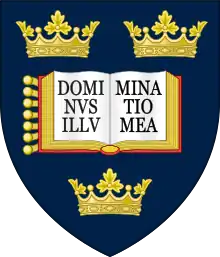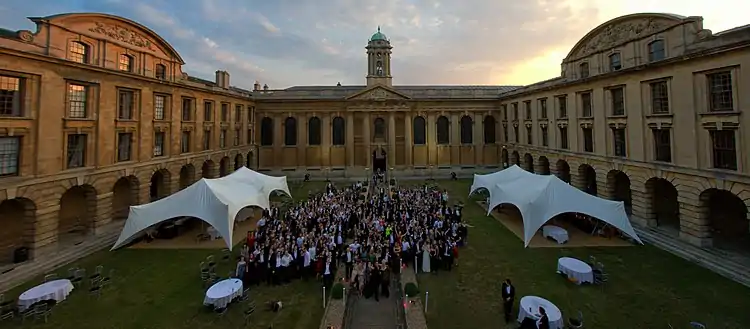| Main page | Indices | Projects |
The University of Oxford portal
The University of Oxford is a collegiate research university in Oxford, England. There is evidence of teaching as early as 1096, making it the oldest university in the English-speaking world and the world's second-oldest university in continuous operation. It grew rapidly from 1167, when Henry II banned English students from attending the University of Paris. After disputes between students and Oxford townsfolk in 1209, some academics fled north-east to Cambridge where they established what became the University of Cambridge. The two English ancient universities share many common features and are jointly referred to as Oxbridge.
The University of Oxford is made up of thirty-nine semi-autonomous constituent colleges, four permanent private halls, and a range of academic departments which are organised into four divisions. All the colleges are self-governing institutions within the university, each controlling its own membership and with its own internal structure and activities. All students are members of a college. It does not have a main campus, and its buildings and facilities are scattered throughout the city centre. Undergraduate teaching at Oxford consists of lectures, small-group tutorials at the colleges and halls, seminars, laboratory work and occasionally further tutorials provided by the central university faculties and departments. Postgraduate teaching is provided in a predominantly centralised fashion.
Oxford operates the Ashmolean Museum, the world's oldest university museum; Oxford University Press, the largest university press in the world; and the largest academic library system nationwide. In the fiscal year ending 31 July 2022, the university had a total consolidated income of £2.78 billion, of which £711.4 million was from research grants and contracts.
Oxford has educated a wide range of notable alumni, including 30 prime ministers of the United Kingdom and many heads of state and government around the world. 73 Nobel Prize laureates, 4 Fields Medalists, and 6 Turing Award winners have matriculated, worked, or held visiting fellowships at the University of Oxford, while its alumni have won 160 Olympic medals. Oxford is the home of numerous scholarships, including the Rhodes Scholarship, one of the oldest international graduate scholarship programmes. (Full article...)
Selected article
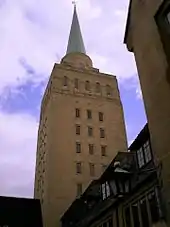
The buildings of Nuffield College are to the west of Oxford's city centre, on the former site of the largely disused basin of the Oxford Canal. Nuffield College was founded in 1937 after a donation to the University of Oxford by the car manufacturer Lord Nuffield. The initial designs of the architect Austen Harrison, which were heavily influenced by Mediterranean architecture, were rejected by Nuffield, who described them as "un-English". Harrison then aimed for "something on the lines of Cotswold domestic architecture", as Nuffield wanted. The college was built to the revised plans between 1949 and 1960. During construction, the tower, about 150 feet (46 m) tall, was redesigned to hold the college's library. Reaction to the architecture has been largely unfavourable. It has been described as "Oxford's biggest monument to barren reaction" and "a hodge-podge from the start". However, the architectural historian Sir Nikolaus Pevsner thought that the tower helped the Oxford skyline and predicted that it would "one day be loved". The writer Simon Jenkins doubted Pevsner's prediction, though, saying that "vegetation" was the "best hope" for the tower, and for the rest of the college too. (Full article...)
Selected biography
Selected college or hall
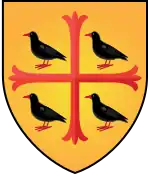
St Edmund Hall, often referred to as "Teddy Hall", was established at some point in the 13th century, probably in about 1278. The college is named after St Edmund of Abingdon, Oxfordshire, the first known Oxford Master of Arts and the first Oxford-educated Archbishop of Canterbury, who lived and taught on the college site. The name St Edmund Hall (Aula Sancti Edmundi) first appears in a 1317 rental agreement. It was the last surviving medieval academic hall at Oxford, only obtaining college status in 1957, and retaining the term "Hall" for reasons of history. It is based on a small central site on the north side of the High Street: the old dining hall dates from 1659, the chapel and old library from the late 17th century, and the library is the 12th-century former church of St Peter-in-the-East. The college has about 375 undergraduates and 175 postgraduates. The Principal is the microbiologist Keith Gull. Alumni of the college include the comedians Terry Jones and Stewart Lee, the former England rugby international Stuart Barnes, the journalist and broadcaster Robin Day, and Ken Macdonald and Keir Starmer, former Directors of Public Prosecutions. (Full article...)
Selected image
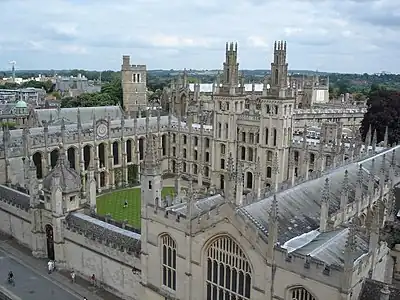
Did you know
Articles from Wikipedia's "Did You Know" archives about the university and people associated with it:

- ... that the Oxford University Museum of Natural History (pictured) was the site of a major debate in evolutionary biology?
- ... that despite being appointed to the usually profitable post of comptroller to Prince Charles in 1616, John Vaughan, 1st Earl of Carbery later claimed that serving the Prince had cost him £20,000?
- ... that Anglican clergyman Chad Varah founded the Samaritans, the world's first crisis hotline, in 1953, at a time when he was also writing for the Eagle comic?
- ... that British barrister Sir Tony Hetherington was the first head of the Crown Prosecution Service after it was founded in 1986?
- ... that the Welshmen Edward Edwards, Griffith Griffith, Owen Owen, Richard Richards, Robert Roberts and Thomas Thomas (and his son Thomas Thomas) were all educated at Jesus College?
Selected quotation
Selected panorama
Wikimedia
The following Wikimedia Foundation sister projects provide more on this subject:
-
 Commons
Commons
Free media repository -
 Wikibooks
Wikibooks
Free textbooks and manuals -
 Wikidata
Wikidata
Free knowledge base -
 Wikinews
Wikinews
Free-content news -
 Wikiquote
Wikiquote
Collection of quotations -
 Wikisource
Wikisource
Free-content library -
 Wikiversity
Wikiversity
Free learning tools -
 Wikivoyage
Wikivoyage
Free travel guide -
 Wiktionary
Wiktionary
Dictionary and thesaurus
